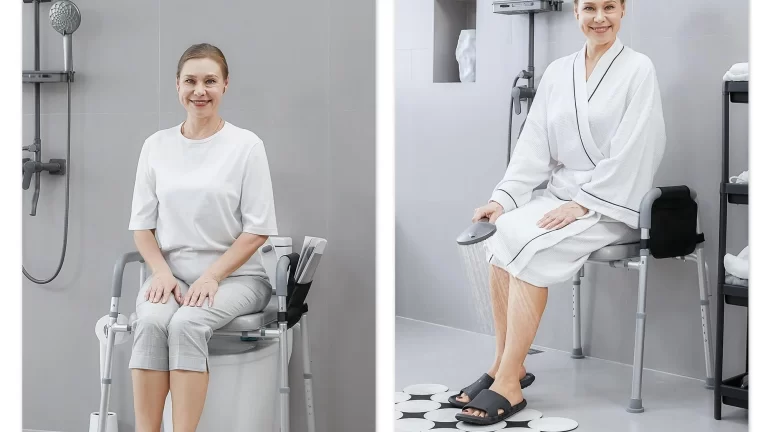A toilet seat riser can be a game-changer for people with mobility issues, making it easier to sit down and stand up from the toilet. But while a raised toilet seat is helpful for many, it’s not for everyone. Some people might find it uncomfortable, unnecessary, or even risky.
So, who shouldn’t use a toilet riser? Let’s break it down in simple terms.
What Is a Toilet Seat Riser?
A toilet seat riser is an attachment that makes your toilet seat higher. It’s designed to help people who have trouble bending or getting up from a low position. Some raised toilet seats come with handles or arms for extra support, while others just add height.
Common types include:
- Basic toilet seat risers – Just a simple raised seat.
- Raised toilet seat with handles – Adds arm support for stability.
- Toilet seat riser with arms – Similar to handles but often more sturdy.
- Locking toilet risers – Attach securely to prevent shifting.
These are great for seniors, people recovering from surgery, or those with mobility issues. But for some, a toilet riser might not be the right choice.
Who Should NOT Use a Toilet Seat Riser?
1. People Who Don’t Have Trouble Sitting or Standing
If you can easily sit down and stand up from the toilet without strain, you probably don’t need a toilet seat riser. It might even feel awkward or unnecessary.
For some, adding extra height can actually make things uncomfortable, especially if they’re used to a standard toilet.
2. People with Good Leg Strength and Balance
A raised toilet seat is meant for people who struggle with bending their knees or putting pressure on their joints. If your legs are strong and your balance is good, you don’t really need the extra height.
Instead, a regular toilet or a slight elevation (like a toilet riser with only a couple of inches of height) might be more suitable.
3. Kids or Shorter Adults
A toilet riser raises the seat several inches, which can make it difficult for shorter individuals—especially kids—to use the toilet comfortably. Their feet may dangle, leading to discomfort and instability.
For children or shorter adults, a toilet seat riser might make it harder to maintain balance or use the toilet properly.
4. People Who Need to Use Their Core Muscles More
Some physical therapists actually don’t recommend a raised toilet seat for certain people recovering from injuries or surgeries. If someone needs to rebuild strength in their core, legs, or lower body, sitting lower (without a riser) can help them work those muscles more.
Always check with a doctor or physical therapist before using a toilet riser after surgery.
5. People Who Have Trouble Keeping Their Feet on the Floor
A raised toilet seat can make it harder for some people to keep their feet flat on the floor, which is important for stability. If your feet don’t reach the ground properly, it can create a tipping hazard or cause discomfort.
For those who struggle with this, a raised toilet seat with handles might help, but in some cases, a lower toilet may actually be safer.
6. People Who Move Around a Lot on the Toilet
Some people shift around while using the toilet, adjusting their position frequently. If that’s you, a toilet seat riser might feel restrictive, especially the ones with arms or handles.
A toilet riser adds height, but it also changes the way you sit. Some find it less comfortable or even frustrating to use.
7. People Who Have a Bidet Attachment
If you use a bidet attachment, adding a toilet riser might interfere with it. Some raised toilet seats don’t fit well with bidets, and the extra height can mess with the water flow.
If you love your bidet and don’t want to give it up, you may need to look for a raised toilet seat that’s specifically designed to be compatible with bidets.
8. Anyone Who Feels Unstable on a Raised Toilet Seat
Not all toilet risers are created equal. Some aren’t as stable as others, and if you feel wobbly or insecure sitting on one, it could be a safety risk.
For extra stability, you might need:
✔ A raised toilet seat with handles for extra support.
✔ A toilet seat riser with arms if you need more grip while standing up.
✔ A secure locking toilet riser to prevent movement.
If you feel unsafe using a toilet seat riser, it’s probably not the right fit for you.
Alternatives to Toilet Seat Risers
If a toilet riser isn’t right for you, here are some alternatives:
✔ A higher toilet – Instead of using a toilet riser, you can install a comfort height toilet, which is naturally higher.
✔ Grab bars – If balance is an issue, wall-mounted grab bars can help instead of a raised seat.
✔ Toilet safety frames – These provide arm support without changing the height of the seat.
✔ Adjustable seats – Some toilets have built-in adjustable heights, offering flexibility.
Do You Need a Toilet Seat Riser?
A toilet seat riser is a fantastic tool for many people—especially those with mobility challenges, joint pain, or recovery needs. But it’s not for everyone.
If you have good leg strength, don’t struggle with sitting or standing, or find raised seats uncomfortable, a toilet riser might not be the best option.
Before making a decision, consider how comfortable and safe it feels for you. If needed, try out different types, like a raised toilet seat with handles or a toilet seat riser with arms, to see what works best.
At the end of the day, comfort and safety matter most. If a toilet riser helps, go for it! But if it makes things harder, there are plenty of other options to keep your bathroom routine safe and comfortable.
